Serving 891 students in grades 6-8, Howard Middle School ranks in the bottom 50% of all schools in Florida for overall test scores (math proficiency is bottom 50%, and reading proficiency is bottom 50%).
The percentage of students achieving proficiency in math is 47% (which is lower than the Florida state average of 52%). The percentage of students achieving proficiency in reading/language arts is 48% (which is lower than the Florida state average of 52%).
The student:teacher ratio of 19:1 is higher than the Florida state level of 17:1.
Minority enrollment is 73% of the student body (majority Black), which is higher than the Florida state average of 65% (majority Hispanic and Black).
Quick Stats (2025)
- School Type: Magnet School
- Grades: 6-8
- Enrollment: 891 students
- Student:Teacher Ratio: 19:1
- Minority Enrollment: 73%
- Overall Testing Rank: Bottom 50% in FL
- Math Proficiency: 47% (Btm 50%)
- Reading Proficiency: 48% (Btm 50%)
- Science Proficiency: 45% (Btm 50%)
- Source: National Center for Education Statistics (NCES), FL Dept. of Education
Top Rankings
Howard Middle School ranks among the top 20% of public schools in Florida for:
Category
Attribute
Diversity
School Overview
Howard Middle School's student population of 891 students has declined by 15% over five school years.
The teacher population of 46 teachers has declined by 16% over five school years.
School Type
Grades Offered
Grades 6-8
Total Students
891 students
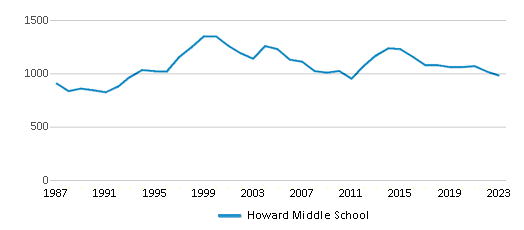
Gender %
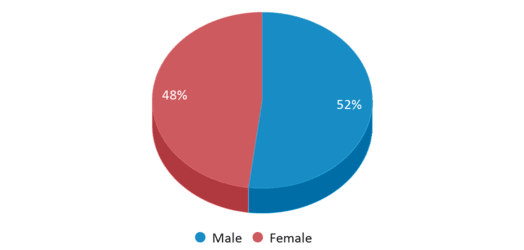
Total Classroom Teachers
46 teachers
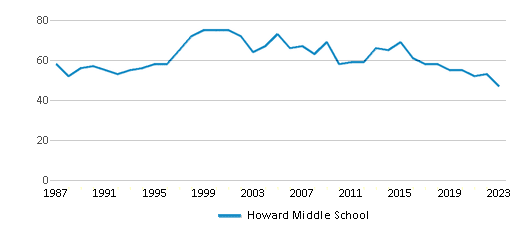
Students by Grade

School Rankings
Howard Middle School ranks within the bottom 50% of all 3,704 schools in Florida (based off of combined math and reading proficiency testing data).
The diversity score of Howard Middle School is 0.74, which is more than the diversity score at state average of 0.70. The school's diversity has stayed relatively flat over five school years.
Overall Testing Rank
#2093 out of 3704 schools
(Bottom 50%)
(Bottom 50%)
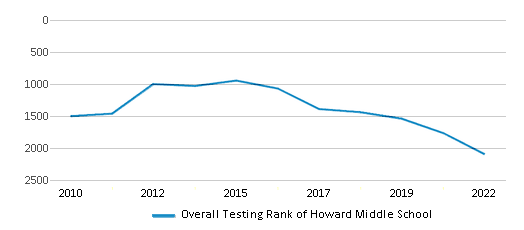
Math Test Scores (% Proficient)
47%
52%
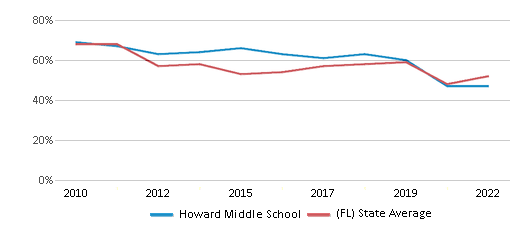
Reading/Language Arts Test Scores (% Proficient)
48%
52%
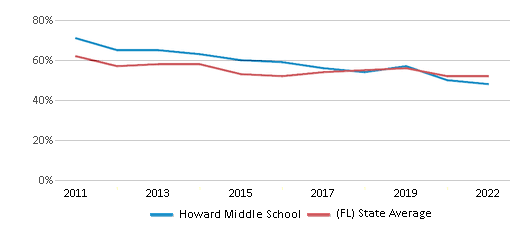
Science Test Scores (% Proficient)
45%
52%
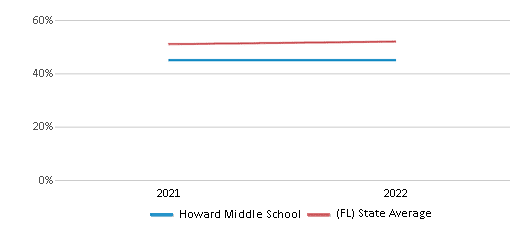
Student : Teacher Ratio
19:1
17:1
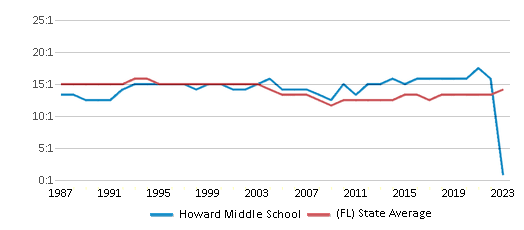
American Indian
n/a
n/a
Asian
7%
3%
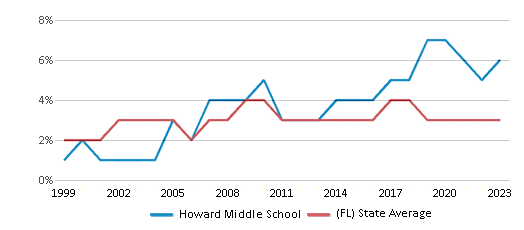
Hispanic
24%
37%
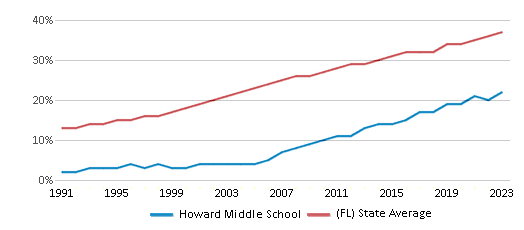
Black
36%
21%
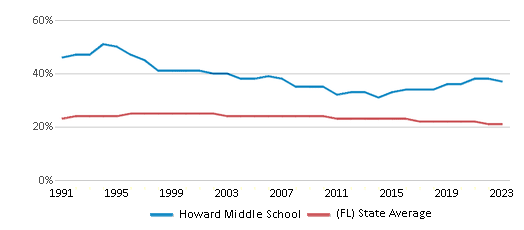
White
27%
35%
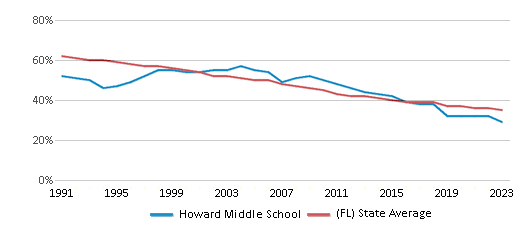
Hawaiian
n/a
n/a
Two or more races
6%
4%
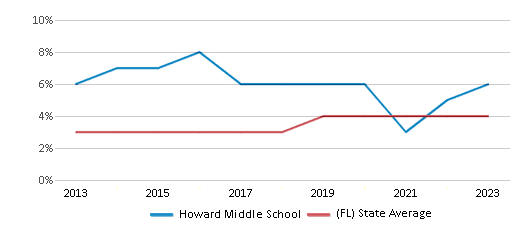
All Ethnic Groups
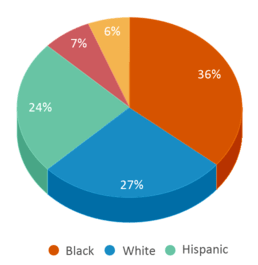
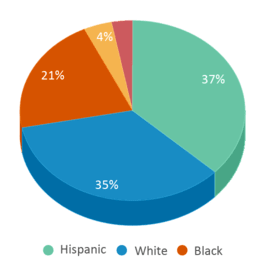
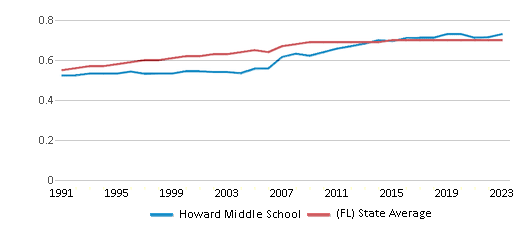
Participates in the National School Lunch Program (NSLP)
Yes
Eligible for Free Lunch
57%
47%
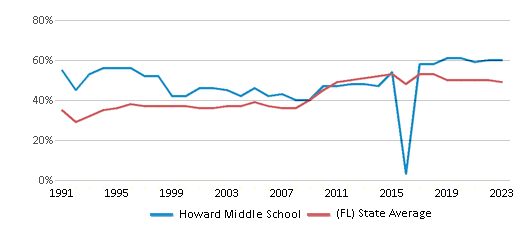
Eligible for Reduced Lunch
3%
4%

School Statewide Testing
School District Name
Source: National Center for Education Statistics (NCES), FL Dept. of Education
Profile last updated: 02/09/2025
Frequently Asked Questions
What is Howard Middle School's ranking?
Howard Middle School is ranked #2093 out of 3,704 schools, which ranks it among the bottom 50% of public schools in Florida.
What schools are Howard Middle School often compared to?
Howard Middle Schoolis often viewed alongside schools like Osceola Middle School, Fort King Middle School, North Marion Middle School by visitors of our site.
What percent of students have achieved state testing proficiency in math and reading?
47% of students have achieved math proficiency (compared to the 52% FL state average), while 48% of students have achieved reading proficiency (compared to the 52% FL state average).
How many students attend Howard Middle School?
891 students attend Howard Middle School.
What is the racial composition of the student body?
36% of Howard Middle School students are Black, 27% of students are White, 24% of students are Hispanic, 7% of students are Asian, and 6% of students are Two or more races.
What is the student:teacher ratio of Howard Middle School?
Howard Middle School has a student ration of 19:1, which is higher than the Florida state average of 17:1.
What grades does Howard Middle School offer ?
Howard Middle School offers enrollment in grades 6-8
What school district is Howard Middle School part of?
Howard Middle School is part of Marion School District.
School Reviews
5 11/3/2022
Going to Howard is an amazing experience where you learn so much and make so many long-lasting friends.
2 5/17/2016
I say this with a resounding "!!!!!!" and this is in light of all the opportunity and academic programs and opportunity's your website says you offer. Being a combat veteran of the U.S Navy and Army for a combined 20 years service, I have come to know certain things as being a constant and a must if you wish to run any organization or group with any level of professionalism and productivity. Most of this is gauged by how you manage the lowest or smallest increment of that product. That is why i say i would not recommend your school. I have surfed your site for an hour and seen all you talk about and boast and your fine points and accalades or reasons a person should enroll their child. In all your self gratifying and edifying you missed one thing or covered it so well in hyperbole that it would take to much time to find. The item i speak of is you "Recommended School Supply List" What is the child to bring in way of school supplys. Where have you hidden this on your website or is it not there at all. If this is normal practice..fine then put it out there where it can be found so a parent (new or otherwise) won't spend uneccesary time looking over your pages of blow harding to find nothing! Get it right!...It matters not if you have the best weapon on the planet if you can't load it or know how to fire it!
Review Howard Middle School. Reviews should be a few sentences in length. Please include any comments on:
- Quality of academic programs, teachers, and facilities
- Availability of music, art, sports and other extracurricular activities
Recent Articles

What Is A Charter School?
Explore the world of charter schools in this comprehensive guide. Learn about their history, how they operate, and the pros and cons of this educational innovation. Discover key facts about charter schools, including admission policies, demographics, and funding, as well as what to look for when considering a charter school for your child.

10 Reasons Why High School Sports Benefit Students
Discover the 10 compelling reasons why high school sports are beneficial for students. This comprehensive article explores how athletics enhance academic performance, foster personal growth, and develop crucial life skills. From improved fitness and time management to leadership development and community representation, learn why participating in high school sports can be a game-changer for students' overall success and well-being.

February 05, 2025
Understanding the U.S. Department of Education: Structure, Impact, and EvolutionWe explore how the Department of Education shapes American education, from its cabinet-level leadership to its impact on millions of students, written for general audiences seeking clarity on this vital institution.





